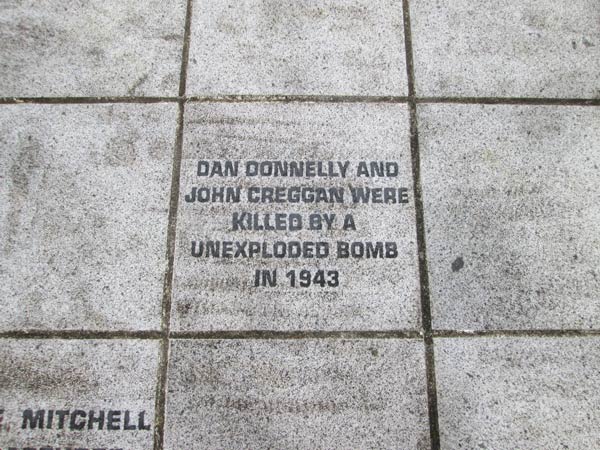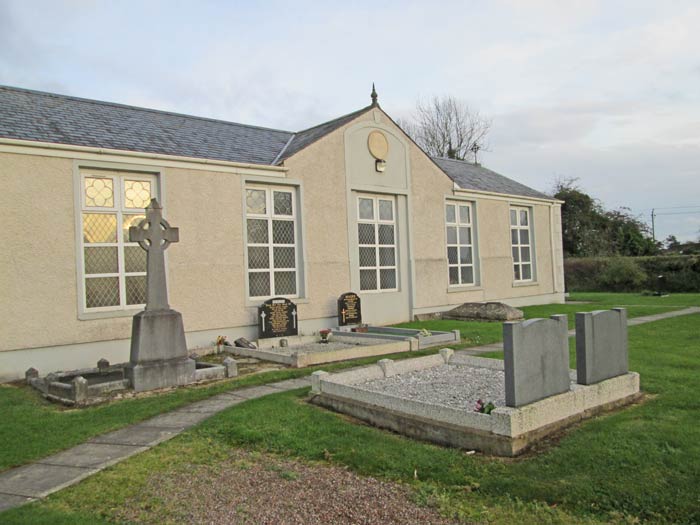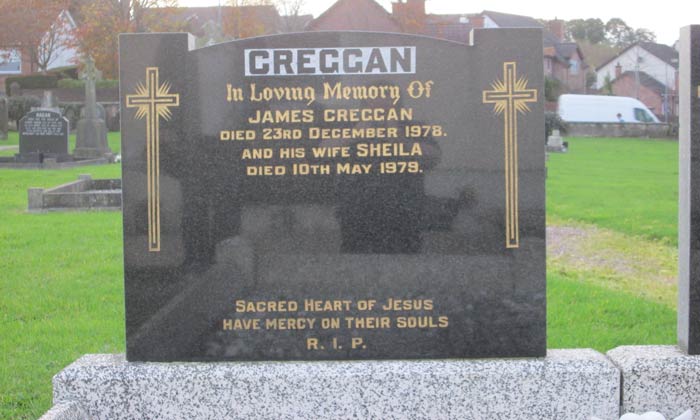| Date |
Information |
|
| 19/12/2019 |
Private E Cosgrove, R.I.F., of Orritor Street |
| 19/12/2019 |
 |
| 19/12/2019 |
Mrs Curran of Drapersfield has been officially notified that her son, Seaman A Curran, is reported missing. He was serving on the aircraft carrier H.M.S. Glorious, believed lost in action in Norwegian waters recently. He had several years service in the Navy. |
| 19/12/2019 |
Intimation was received on Thursday by Mr Robert Larmour of Killymoon Street, Cookstown, that his son, Private R Larmour, R.I.F., is missing. Local men who were with British Expeditionary Force in Flanders who are at present on leave include:- |
| 19/12/2019 |
Private J Larmour, R.U.R., of Orritor Street, Cookstown who was wounded in the leg and his brother Private W Larmour, R.I.F., of Killymoon Street |
| 19/12/2019 |
Sergeant Thomas McGeown, Royal Field Artillery, of Killymoon Street |
| 19/12/2019 |
From the Mid Ulster Mail dated 15th June 1940: Private J Creggan, Pioneer Corps (father of Master John Creggan) |
| 19/12/2019 |
Private Victor Stirrup, R.I.F., of Coagh Street |
| 19/12/2019 |
Private J Creggan, Pioneer Corps, of Killymoon Street |
| 19/12/2019 |
Private James Corey, Pioneer Corps, of Fountain Road |
| 19/12/2019 |
Sergeant R Nixon, Royal Artillery, of Coagh Street |
| 19/12/2019 |
Private P Hagan, Royal Artillery, of Fortview |
| 19/12/2019 |
Sapper Cecil Lee, Royal Engineers, of Red Brae, Tullywiggan |
| 19/12/2019 |
Private W Campbell, Pioneer Corps, of Fortview |
| 19/12/2019 |
Private John McIlree, R.I.F., of Maloon |
| 01/11/2017 |
 |
| 01/11/2017 |
Daniel Donnelly and John Creggan are commemorated on the ‘Leaving a Legacy’ memorial in Gortalowry, Cookstown, adjacent Killymoon Street. |
| 01/11/2017 |
 |
| 01/11/2017 |
 |
| 01/11/2017 |
John Creggan’s father was in the army, stationed in England at the time of his death. |
| 01/11/2017 |
Many thanks to Nigel Henderson of History Hub Ulster, who researched Daniel Donnelly and found that he was buried in Cookstown. |
| 01/11/2017 |
The death certificate confirms his death as 15th February 1943. |
| 31/10/2017 |
'You don’t know the soldier?’ ‘No’ |
| 31/10/2017 |
Coroner – ‘Were you showing any other soldiers that bomb?’ ‘No’ |
| 31/10/2017 |
Harry Hampsey (recalled by the Coroner), reiterated that the soldier handed him the bomb after examining it. |
| 31/10/2017 |
To the Coroner – Any person could get through the wire fencing, and children did very often. The place where the bomb was found was used for bomb throwing practice. |
| 31/10/2017 |
Constable Roberts gave evidence that the field where the bomb was found was fenced with barbed wire, and notice boards warning people of danger where displayed at several points, and a red flag was flying. |
| 31/10/2017 |
Private Walker gave evidence of finding part of an unexploded bomb in the house when he went in with a stretcher party, and Private Geary, a member f an ambulance party which travelled to Omagh with the injured boys, gave evidence that Daniel Donnelly died in the ambulance. |
| 31/10/2017 |
Private George Kemp gave evidence that about 6pm on Sunday, he was walking in Killymoon Street and two children overtook him. One of the children had a bomb in his hand and gave it to the witness who examined it. He did not know what type it was and assumed it was a training bomb. The witness attempted to remove the base plug, but did not succeed. The fuses at the top of the bomb were blackened and looked burned. He struck it hard(?) on the base with his fist to try and loosen the base plug. The witness thought it was a bomb which had been fired and was useless, and threw it into the hedge at the roadside, and told the children to leave it alone and not touch it. They told the witness they found it in the woods at the back of the castle. The witness had since been shown a type of grenade similar to that handed to him by the children. In reply to the Coroner, the witness said that Private O’Reilly accompanied him. |
| 31/10/2017 |
Witness – No |
| 31/10/2017 |
The Coroner – 'Do you know the soldiers you were talking to?' |
| 31/10/2017 |
To the Coroner – 'The place where he got the bomb was wired in, in the centre of the field' |
| 31/10/2017 |
Harry Hampsey, aged twelve, gave evidence that he and the other boys, including the previous witness, went to Killymoon demesne and entered Farley’s field. Noel Blair, who was in front, saw a bomb in the field; it was at a hill with wire all round it. There was a red flag with a ‘W.D’ danger notice. The witness picked up the bomb and went off towards home. He overtook a soldier and asked him if it was any good, and the soldier replied that it was not, so the witness took it home. His mother told him to take it out. Daniel Donnelly, who was in the house, told the witness to throw it in the quarry hole, which is only a short distance from the witness’s home, and when the witness was going to do so, Donnelly snatched it out of his hand. The deceased went along the rear of the houses in the direction of the gable of Mr Boyle’s house. The witness thought he was going to throw the bomb into the quarry hole, and went back into the house and heard the explosion. |
| 31/10/2017 |
John Woods, of Killymoon Street, a boy of eleven, said in evidence that on Sunday afternoon he went to Killymoon Demesne for a stick, and was accompanied by Harry Hampsey and other boys. Earlier in the day he had seen Donnelly and Creggan. In the morning, the witness saw Harry Hampsey pick up a bomb in the demesne; he said ‘Look what I found!” They came over and looked at the bomb. Harry Hampsey ran off towards Cookstown, taking the bomb with him. The witness saw Hampsey talking to two soldiers; he was showing the bomb to them. Hampsey then ran home and the witness did not see him again. The bomb was picked up in Mr Sam Farley’s field, used by the soldiers. |
| 31/10/2017 |
Edward Boyle of Killymoon Street, Cookstown, stated that at 6.25pm he was going around the gable of his house, when he met the boy, Daniel Donnelly, running towards him from the rear of the houses. About three seconds after he passed, the witness heard an explosion. The witness went to the front of the house again and saw Donnelly and Creggan lying on the street, about five feet apart. He lifted Creggan in his arms and saw he was injured. He passed him over to Patrick Smith, a neighbour, and went to Donnelly, and saw he was badly injured. Soldiers arrived very shortly and attended to the injured children. There was a hole in the street about a foot deep, and the windows in the witness’ and adjoining houses were blown out. The witness identified the bodies. Creggan’s father is a serving soldier and Donnelly’s father is working in England. |
| 31/10/2017 |
The other boy, Daniel Donnelly, was dead on arrival at the hospital. Examination of the boy showed that there was a punctured wound on the frontal bone of the skull, exposing the brain. He had a fractured right arm and left leg, and he had multiple superficial wounds. Death was due to shock and multiple injuries. |
| 31/10/2017 |
An inquest was held by Mr A F Colhoun, Coroner, at the County Hospital, Omagh, on Tuesday. Mr J F Dickie appeared for the Crown. Dr William Cullen, house surgeon, gave evidence that John Creggan was admitted to Tyrone County Hospital at 8:45 pm on 14th February, and died just after midnight. He had perforated wounds in the abdomen and stomach, and a chest wound on the left side, and a fractured left leg. His right eye was also punctured and he had also superficial injuries. Death was due to shock and multiple injuries. |
| 31/10/2017 |
 |
| 31/10/2017 |
The boys’ mothers were distraught when they heard what had happened. Added to their misery was the absence of both their husbands. Mr Creggan, who isa private in the army, is stationed in England, and Mr Donnelly is also in England, having gone to work there only quite recently. |
| 31/10/2017 |
Constable Roberts and Rev Captain McCullough, C.F., besides the military medical men, accompanied the ambulance on its long trek of twenty five miles across the moor to Omagh. The two casualties had to be taken there owing to the fact that there is no hospital of any sort in Cookstown. Unfortunately young Donnelly passed away on the journey at Mountfield, only about four miles from Omagh. The ambulance continued on its way in the faint hope that they might save the life of the other boy. However, Creggan also died several hours after his admission to the hospital. |
| 31/10/2017 |
Head Constable Close was the first member of the Royal Ulster Constabulary (R.U.C.) to reach the place, and soon District Inspector Tease, with Sergeant Greer and Constable Roberts arrived to take charge of the situation. Dr M R Neilly (whom is acting for Dr Elliot, at present indisposed) was also there, but the military had already done all that could be done for the lads. |
| 31/10/2017 |
John Woods (recalled), said ‘ I think the soldier gave it back to him.’ |
| 31/10/2017 |
 |
| 31/10/2017 |
Mr Frank Mulgrew, undertaker, Cookstown, had charge of the funeral arrangements.
The mothers, who were very much distressed, have the sympathy of all sections of the community. |
| 31/10/2017 |
A tragic accident occurred in Cookstown on Sunday evening about 6.30 pm, when two young boys, John Creggan, aged 11, and Daniel Donnelly, aged 13, both of Killymoon Street, lost their lives in the explosion of an anti-tank grenade in Killymoon Street, not very far from young Donnelly’s own home. The sound of the explosion was heard over a considerable part of the town and drew many people to the scene of the accident. Nearby houses were damaged, many windows being blown out by the force of the explosion. Military and police rushed quickly to the spot and worked with all possible haste in an attempt to save the lives of the boys. Lieutenant Rennie, an army medical officer, assisted by other army medical men, dressed the wounds of the boys, who were sent to the County Hospital on the arrival of a military ambulance. |
| 31/10/2017 |
Canon Hurson, P.P., officiated at the committal service by the graveside in the Roman Catholic burial ground. |
| 31/10/2017 |
 |
| 31/10/2017 |
 |
| 31/10/2017 |
 |
| 31/10/2017 |
 |
| 31/10/2017 |
 |
| 31/10/2017 |
The CWGC does not list John Creggan. |
| 31/10/2017 |
The remains of the two boys were brought home to Cookstown on Monday evening and they were buried on Tuesday morning in Cookstown. |
| 31/10/2017 |
John Creggan was admitted to Tyrone County Hospital at 8:45pm and died just after midnight. |
| 31/10/2017 |
Daniel Donnelly, aged 13, who also lived at Killymoon Street, was also critically injured. Dan died on the way to Tyrone County Hospital in Omagh. |
| 31/10/2017 |
The mothers of the boys, their little sisters and brothers, and their comrades of St Mary’s Boys School attended the service. At the funeral the schoolboys formed a procession under the charge of their two masters, Messrs Kelly and Leyden. Three pals of the boys walked at each side of the hearses. |
| 31/10/2017 |
Owing to the war-time conditions of travelling, neither Mr Creggan nor Mr Donnelly was able to reach Cookstown in time for the funeral. |
| 31/10/2017 |
The Coroner - ‘Are you sure?’ ‘Yes’ |
| 31/10/2017 |
From the Mid Ulster Mail dated 20th February 1943: Cookstown Double Tragedy – Two boys killed by bomb |
| 31/10/2017 |
The remains of the two boys were brought home to Cookstown on Monday evening and on Tuesday morning Solemn Requiem Mass was conducted by Rev Father S Taggart, C.C., who extended sympathy to the two bereaved families, on the very sad tragedy they had endured. Both boys, he said, were just about to leave school and were on the threshold of manhood. They were intelligent strong healthy boys, but instead of entering manhood, they had been struck down by this disaster. The Rev Father Taggart then went on to deliver a very solemn warning to all boys on interfering with bombs or anything of that nature. |
| 31/10/2017 |
 |
| 31/10/2017 |
District Inspector Tease, and a young army Major, wearing the Victoria Cross ribbon, joined in the expression of sympathy for the relatives. |
| 31/10/2017 |
The coroner, returning a verdict of accidental death, said it was a most unfortunate accident due to the finding of a grenade in a field used for bombing practice. He was not satisfied about how the bomb came to be there. He thought it was a duty of the military authorities not to leave these things lying about. They were told by constable Roberts that children were frequently seen in this field. It was a natural consequence that children, from curiosity, should pick up the bomb, and it should not have been left lying about. There must have been neglect somewhere. It was obvious that Private Kemp did not realise the bomb was dangerous, otherwise he would not have handled it the way he did. He (the Coroner), added a rider to the effect that military authorities should make further enquiries and find out who was responsible for leaving the bomb in the field. He would like to endorse all Mr Dickie said about the danger of picking up unusual objects. He expressed deep sympathy with the bereaved parents. |
| 31/10/2017 |
Mr Dickie, on behalf of the War Department, pointed out that the bomb or grenade had been taken from a recognised bombing range, which was fenced with barbed wire and special warning notices against trespass were displayed, and not only warning notices but a red flag. It would be normally impossible to make the place proof against entrance, especially by children. The place could not always be under supervision. This was one of those unfortunate happenings which was due to the fact that Press and radio warnings not to touch any weapons or unusual objects had been ignored, not only by children, but by other people. It was a most unfortunate happening, and on behalf of the War Department, he tendered deep sympathy to the relatives of the children. |
| 31/10/2017 |
Private Kemp (recalled) said he threw the bomb into the hedge. |
| 31/10/2017 |
‘The soldier tried to screw the end thing off it. He was going to throw it away, and Harry Hampsey said ‘I want it’, and the soldier gave it back to Hampsey. |
| 31/10/2017 |
‘Did you see the soldier take the bomb from him?’ |
| 31/10/2017 |
John Creggan was just 10½ years old when he was critically injured by an unexploded bomb around 6pm at Killymoon Street, Cookstown where he lived on Sunday 14th February 1943. |